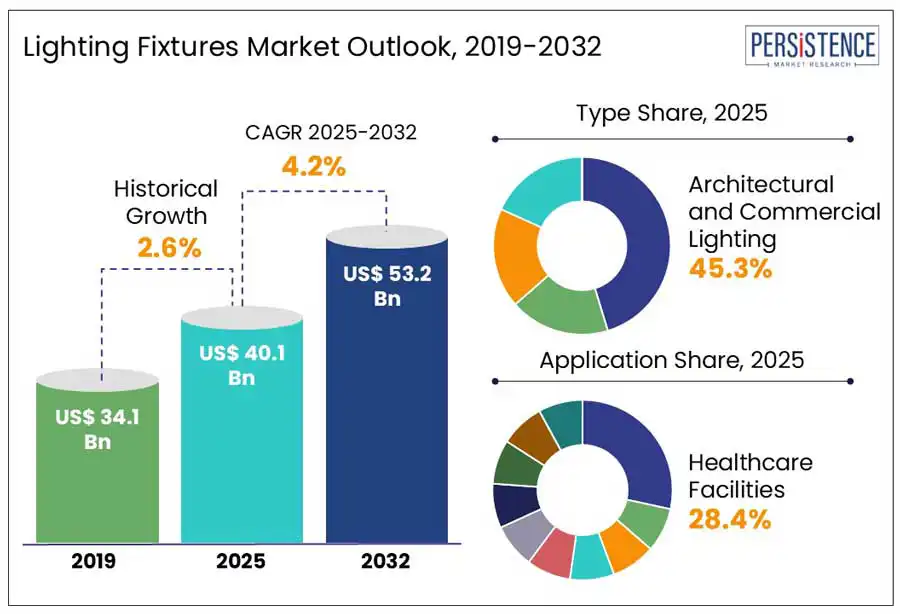ID: PMRREP4716| 150 Pages | 9 Apr 2025 | Format: PDF, Excel, PPT* | Semiconductor Electronics

The global lighting fixtures market size is projected to rise from US$ 40.1 Bn in 2025 to US$ 53.2 Bn by 2032. It is anticipated to witness a CAGR of 4.2% during the forecast period from 2025 to 2032.
Rising demand for energy-efficient lighting solutions in both commercial and residential sectors is estimated to propel the global market. Ongoing development of the real-estate sector and increasing preference for aesthetically appealing residential lighting solutions are also predicted to spur growth.

Key Industry Highlights
|
Global Market Attribute |
Key Insights |
|
Lighting Fixtures Market Size (2025E) |
US$ 40.1 Bn |
|
Market Value Forecast (2032F) |
US$ 53.2 Bn |
|
Projected Growth (CAGR 2025 to 2032) |
4.2% |
|
Historical Market Growth (CAGR 2019 to 2024) |
2.6% |
Implementation of stringent energy efficiency norms in various countries is anticipated to spur lighting fixture demand in the foreseeable future. These norms often carry financial penalties or incentives, making compliance mandatory. The European Union’s Ecodesign Directive and Energy Labelling Regulation, for example, has phased out inefficient halogen and incandescent bulbs, propelling the shift toward LED lighting. Companies failing to meet these Minimum Energy Performance Standards (MEPS) are not allowed to legally sell non-compliant products in the region.
Energy efficiency norms are further tied to sustainability certifications such as Building Research Establishment Environmental Assessment Method (BREEAM) and Leadership in Energy and Environmental Design (LEED). Builders focusing on achieving these certifications must meet specific performance metrics related to lighting fixtures. They are hence investing in LED fixtures to maintain optimal illumination.
Market saturation is expected to be a key limitation to growth. It is especially evident in developed regions such as Western Europe and North America. Over the last few years, these regions have experienced rising adoption of LED lighting fixtures on the back of declining product prices and strict energy-efficiency norms. Hence, most residential and commercial buildings in these regions have completed large-scale LED fixture installation projects.
The bulk of potential customers have already made the switch, resulting in small-scale markets for new lighting fixture sales. LED fixtures often last 15 to 25 years depending on quality and usage, unlike traditional technologies that required frequent replacements. Hence, there is a little requirement for replacement in the short term built-with LED infrastructure reducing the need for device replacement.
The emergence of smart lighting systems is projected to create a new opportunity for lighting fixture manufacturers through 2032. Builders are now demanding innovative fixtures that are compatible with smart home ecosystems such as Apple HomeKit, Amazon Alexa, and Google Home. It is expected to create an attractive market for companies that specialize in designing fixtures embedded with adaptive brightness, wireless connectivity, and sensors.
Retrofitting projects in existing buildings are further anticipated to create new growth avenues. Smart lighting provides a scalable solution for upgrading aging infrastructures. For instance, in countries such as Germany, where about 60% of buildings are more than 30 years old, upgradation with smart lighting fixtures is projected to be a significant strategy to meet national energy-saving goals. This is anticipated to create a high demand for easy-to-install smart lighting fixtures that can be merged without overhauling existing wiring.
Based on type, the market is segregated into architecture and commercial lighting, decorative and residential lighting, industrial lighting, and outdoor lighting. Among these, the architecture and commercial lighting segment is projected to hold a lighting fixtures market share of around 45.3% in 2025, finds Persistence Market Research. Growth is mainly driven by increasing adoption of innovative lighting fixtures in shopping malls, hospitals, warehouses, and offices.
Decorative and residential lighting, on the other hand, is expected to witness a decent CAGR through 2032. It is attributed to the increasing replacement of fluorescent and incandescent bulbs with LED bulbs for home décor to reduce energy use. Launch of new lighting fixtures with unique features such as compatibility with smart devices and comfort dimming is also estimated to fuel demand in smart home projects.
Based on application, the market is divided into airports, corporate campuses, retail outlets, education facilities, government offices and buildings, healthcare facilities, industrial and warehouses, recreation and public venues, residential, restaurants and hotels, and streets. Out of these, healthcare facilities are estimated to generate a share of about 28.4% in 2025. Increasing demand for human-centric lighting fixtures to enhance staff efficiency, reduce stress, and promote healing is projected to drive the segment.
Education facilities, on the other hand, are likely to witness a decent growth through 2032, backed by the increasing awareness of lighting’s effect on student well-being, focus, and performance. For instance, the researchers at the University of Twente, the Netherlands, found that dynamic classroom lighting can enhance alertness, reading speed, and concentration among students. Schools and colleges globally are hence focusing on creating a more conducive and engaging environment, thereby pushing demand for smart lighting fixtures.

In North America, the U.S. lighting fixtures market is envisioned to exhibit considerable growth through 2032. The emergence of various state-level and federal energy efficiency programs, including California’s Title 24 Building Energy Efficiency Standards, is anticipated to push upgrades in lighting fixtures. Megacities such as Los Angeles, New York, and Chicago are embracing smart street lighting fixtures to reduce energy use and maintenance costs.
Los Angeles, has installed more than 215,000 smart streetlights till date, resulting in a predicted 60% fall in energy consumption. Co-working spaces and corporate campuses, on the other hand, are mainly adopting occupancy-based automation and tunable white lighting as part of Environmental, Social, and Governance (ESG) goals.
Asia Pacific is estimated to account for a 48.3% share in 2025. This growth is attributed to the increasing awareness of energy-saving technologies and ongoing infrastructure development. Japan is projected to remain at the forefront with post-Fukushima energy reforms. These have led to increased lighting retrofits in residential and commercial buildings. Local manufacturers such as Toshiba and Panasonic are focusing on creating human-centric, low-energy, and compact lighting solutions.
In India, the market is expected to rise steadily through 2032, backed by the implementation of government schemes to support mass adoption of LED lighting fixtures. The Unnat Jyoti by Affordable LEDs for All (UJALA) scheme, for instance, has distributed over 360 million LED bulbs across public and private infrastructures. Additionally, the Smart Cities Mission is estimated to boost demand for smart lighting systems in urban areas.
In the Middle East and Africa, the UAE is expected to show rapid growth in the forecast period. This is due to increasing high-profile developments such as Abu Dhabi’s Masdar City and Dubai Creek Harbor. These have augmented the adoption of smart lighting fixtures as the country mandates energy efficiency in new infrastructures with the Estidama rating system. Lighting performance is one of the leading parameters of this rating system.
In Nigeria and Kenya, the market is anticipated to showcase average growth due to the requirement for basic access to lighting. Even though unreliable power supply and infrastructure deficits are declining large-scale lighting upgrades in Nigeria, commercial hubs such as Lagos are gradually adopting LED fixtures in offices and malls. In Kenya, companies such as M-KOPA are developing solar kits with energy-efficient lighting systems to cater to households that are beyond the reach of the national grid.
Key companies operating in the global market for lighting fixtures are investing huge sums in research and development activities to create energy efficient and innovative lighting solutions. Smart lighting systems with better visual quality and longer lifespan are the main focus of several companies to strengthen their position. The market is anticipated to see the emergence of various start-ups providing customized solutions for different industries.
The global market is projected to be valued at US$ 40.1 Bn in 2025.
The market is driven by increasing demand for energy-efficient lighting systems and government incentives to propel mass adoption of LED fixtures.
The market is poised to witness a CAGR of 4.2% from 2025 to 2032.
The key market opportunities are rising adoption of circular lighting models and installation of new fixtures in aging infrastructures.
CREE, INC., Hubbell Lighting, Inc., and GE Lighting, LLC are a few key players.
|
Report Attributes |
Details |
|
Historical Data/Actuals |
2019 - 2024 |
|
Forecast Period |
2025 - 2032 |
|
Market Analysis Units |
Value: US$ Bn/Mn, Volume: As Applicable |
|
Geographical Coverage |
|
|
Segmental Coverage |
|
|
Competitive Analysis |
|
|
Report Highlights |
|
|
Customization and Pricing |
Available upon request |
By Type
By Application
By Region
Delivery Timelines
For more information on this report and its delivery timelines please get in touch with our sales team.
About Author